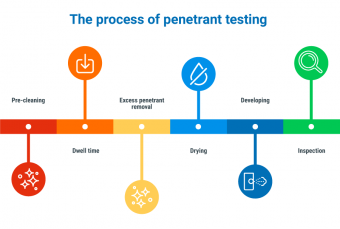PFINDER penetrant testing
What is penetrant testing?
Penetrant testing is a method of non-destructive materials testing in which surface material defects that are open to the surface can be displayed with the aid of so-called penetrant or testing agents. A distinction is made between dye penetrant testing (also called red-white testing), which uses red dyes detectable by daylight, and fluorescent penetrant testing, which uses dyes that become detectable under UV radiation to reveal surface defects.
What are the advantages of penetrant testing?
- Fast and safe
- Location-independent
- Suitable for single part inspection, e.g. crack detection of a weld seam
- Suitable for large quantities
The procedure at a glance
Step 1: Pre-cleaning
The components to be tested must be cleaned superficially so that the test medium can penetrate the existing defects. Residues on the material surface such as scale, slag, rust, etc. must be removed by brushing, sanding, grinding and, if necessary, blasting. Care must be taken to ensure that the defects are not closed by the cleaning process. The components must dry on the surface without leaving any residue.
Step 2: Penetrant process
The penetrant can be applied to the parts to be tested by spraying, brushing, rinsing or dipping. It is essential to ensure that the surface is completely wetted. The penetration time is strongly dependent on the surface and ambient temperature. At low temperatures, the penetration time is prolonged. The test temperature can be in the range of -20 °C to 100 °C.
Step 3: Excess penetrant removal
Completely remove the test agent from the surface by rinsing or spraying with water or a solvent-based cleaner. Caution against over-washing: The test agent must not be washed out of the defects.
Step 4: Drying process
After removing the test agent with water or another cleaner, the surface should be dried with compressed air, a non-fibrous cloth or a suitable drying oven. If a cleaner is used which dries by evaporation due to highly volatile components, the drying process can be omitted.
Step 5: Developing
Immediately after drying, the developer is applied thinly and evenly. Aerosol spray cans or compressed air spray equipment are particularly suitable. The development time depends on the test temperature (component surface). At low temperatures, the development time is prolonged; at high temperatures, it is shortened.
Step 6: Inspection
After the development time has elapsed, the test area is searched for indications, so-called inhomogeneities, in the developer layer. The assessment can also be carried out under UV light using fluorescent inspection agents. The indications initially form as red lines or dots, which can still spread during the development time in the case of larger defects - this is called bleeding.
The width or diameter of the defect opening can only be inferred from the indication to a limited extent. No statement can be made about the depth of the defect opening.
The list of German (DIN) and international (ASTM) can be found here: Wikipedia






